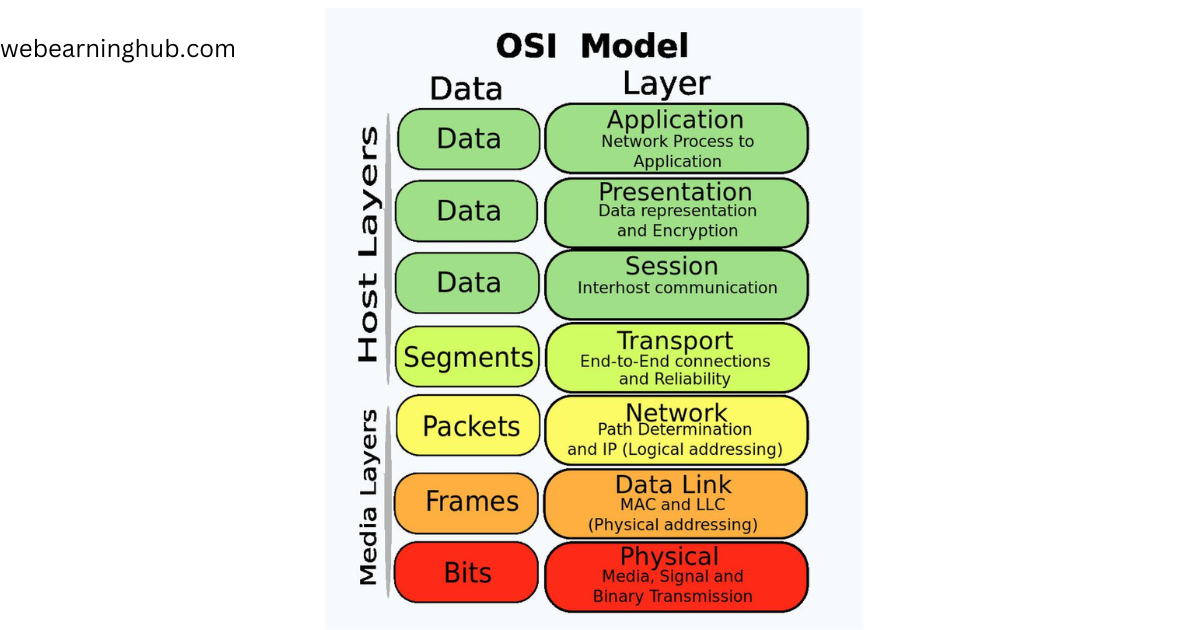What is OSI model?
The OSI model is an internationally recognized set of standards developed by International Standard Organization (ISO) for communication between computer system.
The Open System Interconnection (OSI) model is a conceptual model that has seven layers-
- Application layer
- Presentation layer
- Session layer
- Transport layer
- Network layer
- Data link layer
- Physical layer

1. Physical Layer of OSI Model-
Physical layer is the first and the bottom most layer of the OSI model. This layer is used to establish or terminate a connection medium. It is also defines the electrical and mechanical specification like cables, connectors and signaling option of medium.
In this layer data is in the form of binary.
2. Data Link Layer of OSI Model-
Data link layer handles data transfer, between Network Layer and Physical Layer. It receives data from Network Layer, adds Header and trailer to the data and passes the data to the Physical Layer. All receivers, receives data from Physical Layer, removes the header and trailer and passes the data to the Network Layer.
3. Network Layer of OSI Model-
The data unit in this layer is known as PACKET. The Network Layer is not needed if the two communicating devices lay on the same network. However, when the two devices are on different networks, Network Layer is essential for source to destination delivery of packets.
4. Transport Layer of OSI Model-
It is the fourth layer of OSI model. The data unit of this layer is known as SEGMENT. Transport Layer provides data delivery to the destination. It also check errors in the massage.
Responsibilities of Transport Layer of OSI Model–
a. Service point addressing-
When we transfer data to another computer we need a address port to send data to proper destination. So, Transport Layer add a port address and Using this address it deliver data to appropriate destination.
b. Segmentation and Reassembly-
The massage is divided into segments, each segment having a sequence number. When the data is destroy in the time of transmission process, Transport Layer use these sequence number to retransmit the segment.
c. Connection Control-
It provides connection-oriented or connectionless services. In connection-oriented service the Transport Layer establish a connection to the destination before transmitting the massage. In connectionless service it does not establish connection between sender and receiver and sends the massage using a transmission media.
d. Flow control-
e. Error control-
5. Session Layer of OSI Model-
It is the fifth layer of the OSI Model. It establish, manage, synchronize and terminate connection between computers. It provides half duplex and full duplex services.
Responsibilities of Session Layer of OSI Model–
a. Dialog control-
The Session Layer establish a session between network devices. The dialog can take place either in half duplex or in full duplex mode. Dialog control is implemented using a Data Token. The user that has a Token, is only allowed to send the data.
b. Synchronization-
At the Session Layer, check points (synchronization bits) are added into a stream of data to synchronize the session.
6. Presentation Layer of OSI Model-
It is the sixth layer of the OSI Model. This layer deals with syntax and semantics of the data exchange between two devices. It transforms data in the format that will be accepted by the Application Layer of OSI Model.
Responsibilities of Presentation Layer of OSI Model–
a. Translation-
It translate the data format according to the receiver layer. Presentation Layer of OSI Model change the information from the common format into its receiver dependent format e.g.- One device that uses Extended Binary Coded Decimal Interchange Code (EBCDIC) to present data and another device accepts data using an American Standard Code for Information Interchange (ASCII) to present the same data.
b. Encryption-
Presentation Layer of OSI Model also add security to data by encrypt the data. Encryption is a process in which data is converted into a form that prevent unauthorized uses from reading.
c. Compression-
Data compression is a process of that reduce the number of bits use by the data. It is important while transmitting multimedia files because they are use lots of data processing.
7. Application Layer of OSI Model-
It is the seventh layer of the OSI Model. It provides interface between user and applications. So, user can access the information on the network using an application. It supports also- e-mail, remote file access, transfer and sharing, database management etc.
Function of Application Layer of OSI Model–
a. Network Virtual Terminal-
When a user want to communicate with remote computer, Virtual Network Terminal allow the user to access remote computer resources.
b. File Transfer Access and Management (FTAM)-
Using this application user can access files in a remote location.
c. Mail Services-
Using this application user can forward e-mail to another system. Massage Heading System (MHS) is the OSI protocol use to transfer mails over internet.
d. Directory Services-
Application Layer of OSI Model provides a directory service. A directory is a source of information about the objects – like peoples, organizations, programs and files. The objects are manage by directory services.
==============================*************==============================

2 thoughts on “Know 7 Layers Of OSI Model”